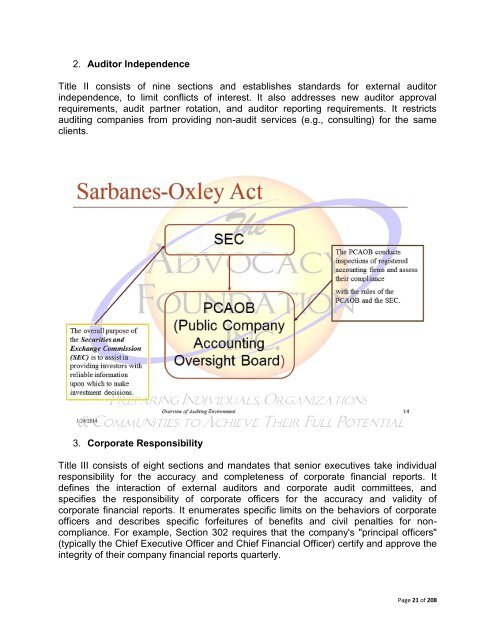The Sarbanes-Oxley Act of 2002
The Sarbanes-Oxley Act of 2002
The Sarbanes-Oxley Act of 2002
Create successful ePaper yourself
Turn your PDF publications into a flip-book with our unique Google optimized e-Paper software.
2. Auditor Independence<br />
Title II consists <strong>of</strong> nine sections and establishes standards for external auditor<br />
independence, to limit conflicts <strong>of</strong> interest. It also addresses new auditor approval<br />
requirements, audit partner rotation, and auditor reporting requirements. It restricts<br />
auditing companies from providing non-audit services (e.g., consulting) for the same<br />
clients.<br />
3. Corporate Responsibility<br />
Title III consists <strong>of</strong> eight sections and mandates that senior executives take individual<br />
responsibility for the accuracy and completeness <strong>of</strong> corporate financial reports. It<br />
defines the interaction <strong>of</strong> external auditors and corporate audit committees, and<br />
specifies the responsibility <strong>of</strong> corporate <strong>of</strong>ficers for the accuracy and validity <strong>of</strong><br />
corporate financial reports. It enumerates specific limits on the behaviors <strong>of</strong> corporate<br />
<strong>of</strong>ficers and describes specific forfeitures <strong>of</strong> benefits and civil penalties for noncompliance.<br />
For example, Section 302 requires that the company's "principal <strong>of</strong>ficers"<br />
(typically the Chief Executive Officer and Chief Financial Officer) certify and approve the<br />
integrity <strong>of</strong> their company financial reports quarterly.<br />
Page 21 <strong>of</strong> 208

















